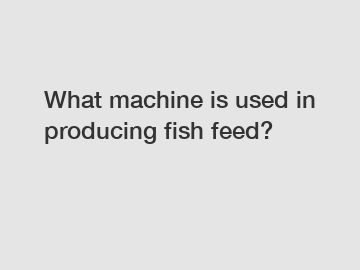What machine is used in producing fish feed?
In our quest to meet the ever-growing demand for seafood and address the sustainability concerns associated with overfishing, aquaculture has emerged as a promising solution. Among the many factors crucial to successful fish farming, the production of high-quality fish feed takes center stage. Transforming raw ingredients into nutritious pellets requires advanced machinery designed to optimize feeding efficiency and environmental sustainability. In this blog, we dive into the fascinating world of fish feed production and explore the innovative machines powering the industry forward.
1. High-Quality Extruders:
At the core of fish feed production lies the extrusion process, wherein raw materials are transformed into uniform pellets. High-quality extruders with innovative features are essential for achieving the desired nutritional composition, palatability, and mechanical durability of the feed. These machines meticulously control parameters such as temperature, pressure, and moisture content to ensure optimal pellet formation and nutrition retention.

2. Preconditioners:
Preconditioners play a vital role by improving the texture, digestibility, and water stability of fish feed. Particularly in floating pellet production, preconditioning before extrusion helps incorporate essential nutrients, additives, and binders into the mix. These machines create the perfect blend of ingredients necessary for floating feed, ensuring a controlled expansion during extrusion to achieve buoyancy.
3. Microingredient Additions:
Fish nutrition is a complex science, requiring precise dosages of vitamins, minerals, probiotics, enzymes, and other additives to enhance the health and growth of fish. Modern fish feed manufacturing machines allow for the accurate addition of microingredients. Sophisticated metering and dosing systems enable producers to create customized feed formulations tailored to specific aquatic species, growth stages, and environmental factors.
4. Automation and Control Systems:
In today's fish feed production, automation and digital control systems have revolutionized the production process. Cutting-edge technology platforms integrate sensors, data loggers, and artificial intelligence to monitor and adjust key parameters in real-time. This ensures consistent product quality, minimizes waste, reduces energy consumption, and optimizes overall efficiency. By enabling precise control over the manufacturing process, these machines facilitate a remarkable degree of reproducibility and customization.
5. Sieving and Cooling Equipment:
After extrusion, the freshly formed fish feed pellets require further processing to achieve their final form. Sieving machines sift out unevenly shaped or oversized pellets, ensuring uniformity in size and texture. Cooling equipment lowers the temperature of the pellets, stabilizing their structure and preventing crumbling during handling and storage.
6. Packaging and Weighing Systems:
To ensure that fish feed reaches its intended destination in optimal condition, modern packaging machines deliver efficient and hygienic packaging solutions. These machines expertly weigh the pellets and seal them in appropriate packaging materials, preserving their nutritional value and preventing moisture absorption or contamination. Advanced package tracking systems provide valuable information on production batches, expiration dates, and batch traceability, ensuring transparency and quality control.
Conclusion:
Fish feed production machines have come a long way in supporting sustainable aquaculture practices. By combining cutting-edge technology with meticulous craftsmanship, these machines produce nutritionally balanced and environmentally friendly feed for fish, crustaceans, and other aquatic species. Increased automation, stringent quality control, and precise dosing mechanisms have elevated the industry's performance, allowing for greater productivity and, consequently, a reduction in environmental impact. As we continue to push the boundaries of innovation, the machines used in producing fish feed will only continue to evolve, ultimately contributing to a thriving and more sustainable global aquaculture sector.
Are you interested in learning more about animal feed coating, animal feed conditioner, feed pellet machine conditioner? Contact us today to secure an expert consultation!


